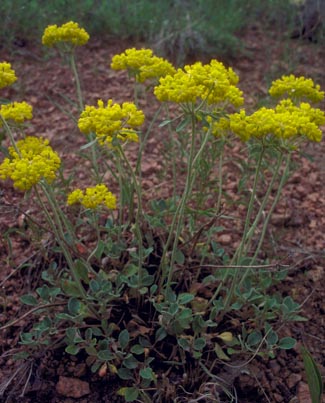Sulfur Buckwheat

Common Name(s):
Sulfur Buckwheat
Sulphur-flower Buckwheat
Sulfur Flower
Scientific Name:
Eriogonum umbellatum Torr.
Scientific Name Synonyms:
None Known
Symbol:
ERUM
Description:
Life Span: Perennial
Origin: Native
Growth Characteristics: Sulfur buckwheat is a very widespread and variable species, with 40 different varieties occurring in North America. Plants can range from low, dense tufted, matted perennial forbs to large spreading shrubs. Sulfur buckwheat grows from a tufted, more or less woody crown and root. The foliage is grey.
Flowers: Long lasting, ball-like clusters (umbel) of flowers. Colors can be yellow, cream to red or purple. Flowers appear from June through August.
Fruits/Seeds: An achene.
Leaves: The leaves are arranged in loose to compact basal rosettes, the leaf-blades are oval to round, dense white-woolly beneath. The leaves are evergreen, but some change to red in the fall.
Stems: Stalks are up to 12 inches tall and leafless.
Ecological Adaptions:
Sulfur Buckwheat grows in open dry sites in valleys and on mountain slopes up to subalpine elevations. It prefers full sun
Soils: Dry, well drained soils.
Associated Species: Big sagebrush, Utah serviceberry, Douglas fir, lodgepole pine, Utah Juniper, pinyon pine, Aspen.
Uses and Management:
Livestock like to eat the flowers. It is used as an ornamental plant in very dry climates.

